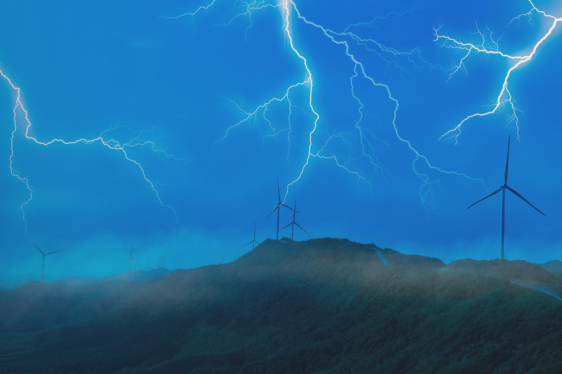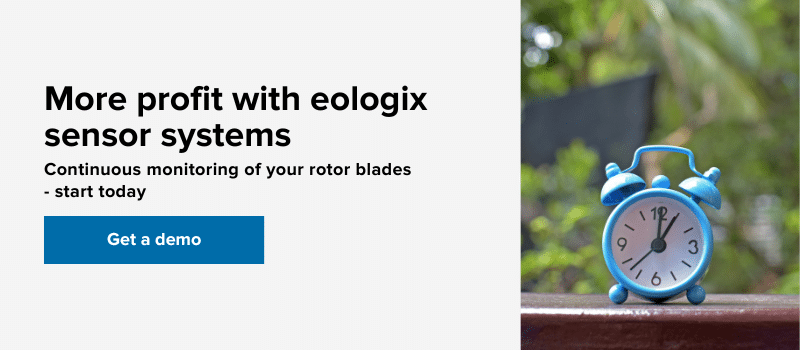TECHNOLOGy | 6 MIN TO READ
Affected by lightning - the most lightning-prone areas in the USA
Would you like to know if your wind turbine has been struck by lightning before the next regular inspection interval?

Recent data from NASA published in “Outside” from David Ferry and the Federal Office of Meteorology and Climatology MeteoSwisse, alongside the 2023 Annual Lightning Report from Vaisala, corroborate a global surge in lightning activity attributed to climate change.
This trend is particularly pronounced in the US, with the report pinpointing highly affected regions and highlighting the increased frequency of lightning strikes in wind turbine areas. Such findings present formidable challenges for operators in managing and safeguarding their infrastructure.
Highlights
- 31% of US wind farms had one or more lightning strokes per turbine in 2023
- ~242 million total lightning events across the US in 2023 (compared to ~198 million in 2022)
- In 2023, Texas claimed the top spot with a staggering 42,388,860 lightning events, solidifying its position as the state most frequently struck by lightning
Affected regions in the US
The latest Annual Lightning Report reveals striking figures for 2023, documenting 242,101,157 in-cloud and cloud-to-ground lightning events across the continental United States, with a global total of 2,102,170,206 lightning occurrences.
Leading the nation with 120,998 cloud-to-ground lightning strikes, the Miami–Fort Lauderdale metropolitan area in Florida stands out. Additionally, areas like Houston, Texas; Atlanta, Georgia; the Dallas–Fort Worth–Arlington region in Texas; and the New York–Jersey City–Newark metropolitan area also experience high levels of lightning activity.
Specifically, a wind farm located in Hansford County, Texas, and another spanning Blaine and Custer Counties in Oklahoma, experienced over 1,000 lightning strokes each, as highlighted in the report. Notably, in Oklahoma, a wind farm situated in Pushmataha County saw an average of 14.4 lightning strokes per turbine in 2023, closely followed by a wind farm in Freeborn County, Minnesota, with an average of 12 lightning strokes per turbine.
Remarkably, three wind farms received an average of more than 10 cloud-to-ground lightning strokes per turbine, signifying the significant impact of lightning activity on these installations.
Conversely, it’s noteworthy that approximately one-third of wind farms in the United States reported no lightning strikes at all throughout 2023, offering a glimmer of hope amidst the prevalence of lightning strikes in certain regions.
Impact on wind farms
The surge in lightning activity poses challenges not only for the natural environment but also for wind turbine operators. Comprehensive analysis indicates a total of 77,494 lightning strikes occurring at or near 1,500 wind farms in the United States during 2023 alone.
It is evident that turbines are vulnerable to damage during periods of heightened lightning activity. Experts estimate that approximately 60% of blade losses and nearly 20% of operational losses can be attributed to lightning damage.
Read more about our acoustic lightning detection system.
Summary
In summary, the escalating prevalence of lightning activity across the United States presents formidable challenges for both environmental sustainability and critical infrastructure like wind farms. As the frequency of lightning strikes continues to rise, wind turbine operators are tasked with the crucial responsibility of safeguarding their investments and ensuring uninterrupted energy production.
While certain regions experience disproportionately high lightning density, the variability in strike frequency underscores the necessity for robust protection measures. As we navigate the dynamic landscape of renewable energy, it is paramount for stakeholders to prioritize safety, reliability, and resilience in the face of natural hazards like lightning.
By adopting advanced monitoring systems and proactive maintenance protocols, the wind industry can significantly reduce risks, enhance operational efficiency, and minimize downtime. Our on-tower lightning detection system serves as a crucial component in this strategy, enabling the early identification of lightning strikes on turbines, complete with timestamps. When coupled with our surface damage monitor, this integrated solution empowers operators with timely information to respond swiftly and decisively to potential threats. By leveraging these cutting-edge technologies, operators can effectively safeguard their assets and ensure the continued reliability and productivity of wind energy infrastructure.







